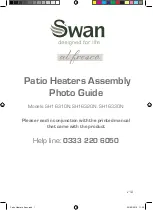
WARNING!
There are always dust particles in the air in every living space, even if it is regularly
vacuumed! These particles are visible in rays of sunlight and they will not bother you
as long as the concentration of particles in the air remain low. The indoor climate can
only be described as bad if these particles are floating through the room in large quali-
ties for any reason whatsoever and if the air is additionally polluted by soot and tar
particles caused by the burning if oil lamps for example, and by smoking cigarettes
and cigars. In a heated living space, cooled air slowly streams across the floor to the
combustion appliance. The air is heated in the convection system of the heater, caus-
ing a fast rising column of warm air to develop, which then spreads throughout the
room again. As a consequence, this air always contains dust and other pollutant parti-
cles that may leave deposits on cold and often damp surfaces. This is potentially a
particular problem in new buildings that are not yet dry (construction moisture). An
unwelcome result of this phenomenon could be discolouration of walls and /or ceilings.
Wait at least 6 weeks before firing a newly bricked room or after renovations, since the
construction moisture must have disappeared completely from the walls, floor and
ceiling. The room where the appliance is located must be well ventilated and the re-
quired ventilation must be in compliance with the Installation Instruction. Do not use
candles or oil lamps. These provide considerable quantities of pollutant and unhealthy
soot particles in your home. Smoke from cigarette and cigars contain tarry substances,
which may also leave deposits on colder and damp walls when heated. If the interior
climate is bad, this phenomenon may also occur above radiators and lighting fixtures
and at ventilation grilles, although to a lesser degree. If decorating around the heater
ensure that adequate precautions are taken to prevent paint etc from coming into
contact with the heater. Do not use masking tape on the front panel.
3. CLEARANCES
To electrical devices
- Under no circumstances must any electrical device (e.g Plasma T.V.) be wall mount-
ed above a firewall.
To combustibles -
Minimum clearance to the sides of the heater are 100 mm (4in) but curtains, drapes and
other fabrics are not permitted within a distance of 500 mm (20 in) of the stove sides. No such materials are
permitted directly above the heater regardless of distance. Clearances to the front of the heater is 1000 mm
(39 in). A combustible shelf may be fixed to the wall above the heater, providing that it complies with the di-
mensions given below and is rated a minimum of 100°C otherwise discolouration or smells may occur. If in
doubt refer to the shelf manufacturer. The shelf depth may be increased up to a maximum of 457mm (18") but
the height must also be increased accordingly. An increase in height of 25 mm is required for every 12.5 mm
of additional shelf depth. For shelves that are too low, protective devices can be used such as metal heat
deflectors, but it must be assured that the shelf does not reach an unacceptable temperature before relying on
such a solution.
Maximum depth of
shelf
Minimum distance from top of
outlet grille to underside of shelf
75mm (3in)
305mm (12in)
150mm (6in)
457mm (18in)
457mm (18in)
1067mm (42in)
As with all heating appliances, any decora-
tions, soft furnishings, and all coverings (i.e.
flock, blown vinyl and embossed paper)
positioned too close to the appliance may
discolour or scorch.
Page 3




























